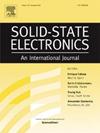通过高频交流载流子注入减轻letid诱导的性能损失:晶体硅太阳能电池中与结构相关的恢复趋势
IF 1.4
4区 物理与天体物理
Q3 ENGINEERING, ELECTRICAL & ELECTRONIC
引用次数: 0
摘要
光和高温诱导降解(LeTID)是晶体硅(c-Si)太阳能电池的主要可靠性问题,特别是那些含有富氢钝化层的太阳能电池。本研究研究并比较了PERC、TOPCon和HJT细胞在85°C 1次太阳照射下的降解和恢复行为。PERC电池表现出最高的降解,由于氢诱导形成Fe-H和BO-H配合物,η损失为16.6%。由于隧道氧化物和多晶硅界面的缺陷积累,TOPCon电池的性能下降了12.5%。相比之下,HJT电池仅表现出6.3%的减少,因为氢仍然被限制在非晶硅层中。采用100 kHz的高频交流载波注入来促进电恢复。PERC、TOPCon和HJT的再生效率分别为93.1%、94.7%和99.8%。恢复是由重组增强的缺陷反应驱动的,该反应解离氢相关的缺陷复合物并使重组中心重新钝化。对比分析表明,氢动力学、钝化稳定性和缺陷激活途径决定了降解严重程度和回收效率。结果验证了交流载流子注入是一种有效的、架构自适应的策略,可以缓解LeTID并提高c-Si光伏电池的长期性能。本文章由计算机程序翻译,如有差异,请以英文原文为准。
Mitigating LeTID-Induced performance loss through high-frequency AC carrier injection: Architecture-dependent recovery trends in crystalline silicon solar cells
Light- and Elevated Temperature-Induced Degradation (LeTID) is a major reliability concern in crystalline silicon (c-Si) solar cells, especially those incorporating hydrogen-rich passivation layers. This study investigates and compares the degradation and recovery behavior of PERC, TOPCon, and HJT cells under 1-sun illumination at 85 °C. PERC cells showed the highest degradation, with a 16.6 % η loss due to hydrogen-induced formation of Fe–H and BO–H complexes. TOPCon cells experienced a 12.5 % decline, attributed to defect accumulation at the tunnel oxide and poly-Si interface. In contrast, HJT cells exhibited only a 6.3 % reduction, as hydrogen remained confined within the amorphous silicon layer. High-frequency AC carrier injection at 100 kHz was applied to promote electrical recovery. The regenerated efficiencies reached 93.1 % in PERC, 94.7 % in TOPCon, and 99.8 % in HJT cells. Recovery was driven by recombination-enhanced defect reactions that dissociate hydrogen-related defect complexes and enable re-passivation of recombination centers. This comparative analysis reveals that hydrogen dynamics, passivation stability, and defect activation pathways determine both degradation severity and recovery efficiency. The results validate AC carrier injection as an effective and architecture-adaptive strategy for mitigating LeTID and enhancing the long-term performance of c-Si photovoltaics.
求助全文
通过发布文献求助,成功后即可免费获取论文全文。
去求助
来源期刊

Solid-state Electronics
物理-工程:电子与电气
CiteScore
3.00
自引率
5.90%
发文量
212
审稿时长
3 months
期刊介绍:
It is the aim of this journal to bring together in one publication outstanding papers reporting new and original work in the following areas: (1) applications of solid-state physics and technology to electronics and optoelectronics, including theory and device design; (2) optical, electrical, morphological characterization techniques and parameter extraction of devices; (3) fabrication of semiconductor devices, and also device-related materials growth, measurement and evaluation; (4) the physics and modeling of submicron and nanoscale microelectronic and optoelectronic devices, including processing, measurement, and performance evaluation; (5) applications of numerical methods to the modeling and simulation of solid-state devices and processes; and (6) nanoscale electronic and optoelectronic devices, photovoltaics, sensors, and MEMS based on semiconductor and alternative electronic materials; (7) synthesis and electrooptical properties of materials for novel devices.
 求助内容:
求助内容: 应助结果提醒方式:
应助结果提醒方式:


